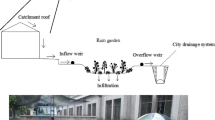Abstract
Because of climate change, severe rainfall events that lead to lowland flooding and inundation problems are occurring more frequently, especially in urban areas, which have high population densities. In order to prevent inundation of urban areas, authorities in the Korean Government have set up integrated flood management plans and established spatial targets for rainfall runoff. These disaster prevention plans include measures such as improvements to the sewer pipe capacity and the construction of downstream pump stations, rainwater storage sites, and infiltration facilities. The main purpose of pervious design plans is to reduce the flood volume in target areas, and this research presents a new method for developing rainwater storage design plans while considering potential flood damage costs in urban areas. The new planning method for storage facility design was applied to a single watershed in the Sintaein basin in the city of Jeongeup, Jeonbuk, South Korea. The results indicated that flood damage costs could be reduced when this new concept for determining the location of storage facilities is used.
Similar content being viewed by others
References
AL-Hamati, A. A. N., Ghazali, A. H., and Mohammed, T. A. (2010). “Determination of storage volume required in a sub-surface stormwater detention/retention system.” Journal of Hydro-environment Research, Vol. 4, No. 1, pp. 47–53, DOI: 10.1016/j.jher.2009.12.002.
Andrés-Doménech, I., Montanari A., and Marco, J. B. (2010). “Stochastic rainfall analysis for storm tank performance evaluation.” Hydrology and Earth System Sciences, Vol. 14, No. 7, pp. 1221–1232.
Andrés-Doménech, I., Montanari, A., and Marco, J. B. (2012). “Efficiency of storm detention tanks for urban drainage systems under climate variability.” Journal of Water Resources Planning and Management, Vol. 138, No. 1, pp. 36–46.
Baek, C.W., Lee, J. H., and Paik, K. (2012). “Optimal location of basinwide constructed washlands to reduce risk of flooding.” Water and Environment Journal, Vol. 28, No. 1, pp. 52–62.
Behera, P. K., Papa, F., and Adams, B. J. (1999). “Optimization of regional storm-water management systems.” Journal of Water Resources Planning and Management, Vol. 125, No. 2, pp. 107–114.
Chill, J. and Mays, L. W. (2013). “Determination of the optimal location for developments to minimize detention requirements.” Water Resources Management, Vol. 27, pp. 5089–5100.
Chung, J. H., Han, K. Y., and Kim, K. S. (2008). “Optimization of detention facilities by using multi-objective genetic algorithms.” Journal of Korea Water Resources Association, Vol. 41, No. 12, pp. 1211–1218.
Gaudio, R., Penna, N., and Viteritti, V. (2015). “A combined methodology for the hydraulic rehabilitation of urban drainage networks.” Urban Water Journal, pp. 1–13.
KOSTAT (2012). Statistics of National Asset.
Lee, E. H., Lee, Y. S., Joo, J. G., and Kim, J. H. (2016). “Development of operation in urban offline detention reservoirs.” Journal of the Korean Society of Hazard Mitigation, Vol. 16, No. 1, pp. 227–236.
Lim, S., Ho, V. H., Lee, S. Y., Yoo, D. G., and Kim, J. H. (2014). “Determination of optimal location and capacity of detention.” Procedia Engineering, Vol. 70, pp. 1037–1045.
MOLIT (2004). Study on the Economic Analysis of Flood Control Project.
MOLIT (2011a). Improvement and Supplement of Probability Rainfall in South Korea.
MOLIT (2011b). Korea Probability Rainfall Information.
Mousavi, H. and Ramamurthy, A. S. (2002). “Multi-reservoir design using Pontryagin principle.” Advances in Water Resources, Vol. 25, No. 7, pp. 829–839.
Ryu, S. H. and Lee, J. H. (2012). “Determination of optimal locations and size of storage in the urban sub-surface using genetic algorithm.” Journal of the Korean Society of Hazard Mitigation, Vol. 12, No. 3, pp. 285–290.
Tao, T., Wang, J., Xin, K., and Li, S. (2014). “Multi-objective optimal layout of distributed storm-water detention.” International Journal of Environmental Science and Technology, Vol. 11, No. 5, pp. 1473–1480.
Yazdi, J. and Salehi Neyshabouri, S. A. A. (2012). “Optimal design of flood-control multi-reservoir system on a watershed scale.” Natural Hazards, Vol. 63, No. 2, pp. 629–646.
Author information
Authors and Affiliations
Corresponding author
Rights and permissions
About this article
Cite this article
Choi, H., Lee, E.H., Joo, J.G. et al. Determining optimal locations for rainwater storage sites with the goal of reducing urban inundation damage costs. KSCE J Civ Eng 21, 2488–2500 (2017). https://doi.org/10.1007/s12205-016-0922-6
Received:
Revised:
Accepted:
Published:
Issue Date:
DOI: https://doi.org/10.1007/s12205-016-0922-6




